Sheffield Wednesday
Sheffield is the crucible of football, boasting the world's oldest clubs, Sheffield FC and Hallam FC formed in 1857 and 1860 respectively. On Wednesday 4th September 1867 the Wednesday Cricket Club formed a football branch to keep members together during the winter season. The cricket team played on Wednesday afternoons when members, craftsmen, shopkeepers and clerks, had a half day off work. The new club was officially named The Wednesday Cricket & Football Club. Although they were frequently referred to as Sheffield Wednesday, the club did not formally adopt this title until 1929.
In their first ever game, The Wednesday defeated the Mechanics Club by three goals and four "rouges" to nil. Under "Sheffield Rules", the goal posts were four yards apart and a second pair of vertical posts stood four yards to either side. If the ball passed between these outer posts and was touched down by the attacking side, a rouge was scored: if teams finished level on goals, the one with the most rouges was the winner. The club's colours were royal blue and white although this was before the introduction of uniform kits. Players wore whatever they had to hand adorned by royal blue caps, scarves or sashes. The club has retained these colours throughout its long history.
By the late 1870s the team wore hooped jerseys but many variations were apparent. The team photograph reproduced above shows several different styles of jersey, two players are wearing self-coloured jerseys one of which bears what may be the crest of the Sheffield FA. Furthermore various knickerbockers, ducks and hose are apparent. This motley appearance was typical of the period.
By 1883 the club was one of the strongest in the country and the footballers split from the cricket club arguing that they earned all the money while the cricketers merely spent it. In 1886 the club secretary forgot to submit Wednesday's application to the English FA Cup in time and several leading players defected to a local works side, Lockwood Brothers FC in order to play in the competition. They then threatened to form a breakaway professional club, Sheffield Rovers, but after protracted negotiations they were persuaded to return to The Wednesday in return for payment of 5 shillings (25p) per home game and 7/6d (37.5p) for an away game. On 22 April 1887, The Wednesday formally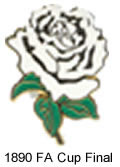 became a professional team.
became a professional team.
Wednesday were overlooked when the Football League was founded in 1888 so the club president formed the rival Football Alliance in 1889, winning the championship at the first attempt. They also reached the FA Cup final, the first Yorkshire team to do so, but were beaten by Blackburn Rovers. A white rose was embroidered onto the pale blue shirts worn in this match.
In 1892 the Alliance was incorporated into the Football League as Division Two and in the process The Wednesday were elected to play in Division One. After two consecutive semi-final appearances The Wednesday won the FA Cup in 1896. After a single season in Division Two (1898-99) the club were First Division champions in 1903 and 1904 and won the FA Cup again in 1907.
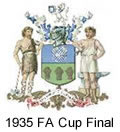 In 1920 the club were again relegated but returned as Division Two champions in 1926 and went on to win consecutive Division One titles for the second time (1929 and 1930). Around 1929 the club formally adopted the title of "Sheffield Wednesday." In 1935 they won the FA Cup for the third time. As was customary, the city's coat of arms were worn on the shirts in the final.
In 1920 the club were again relegated but returned as Division Two champions in 1926 and went on to win consecutive Division One titles for the second time (1929 and 1930). Around 1929 the club formally adopted the title of "Sheffield Wednesday." In 1935 they won the FA Cup for the third time. As was customary, the city's coat of arms were worn on the shirts in the final.
Two years later, Wednesday were back in Division Two.
In the final year of wartime competition (1945-46), Wednesday were unable to obtain their traditional vertical blue and 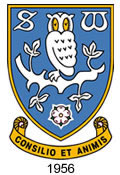 white shirts so played in hooped jerseys instead, a style they had previously worn in the reign of Queen Victoria.
white shirts so played in hooped jerseys instead, a style they had previously worn in the reign of Queen Victoria.
During the 1950s, the "Owls" (the club's home is in the Owlerton district of Sheffield) were promoted and relegated between the top two divisions with bewildering frequency. The club's first official crest was adopted in 1956 but was never used on the team's shirts. This featured an owl, which would become the regular motif of future crests along with the club's Latin motto (which translates as "By Wisdom and Courage").
The 1960s were spent in the First Division and included an FA Cup final appearance in 1966. This period saw a departure from Wednesday's traditional stripes when a smart blue shirt with white sleeves was adopted. In 1970 Wednesday were relegated and in 1975 they dropped into the Third Division for the first time.
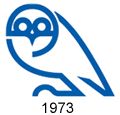 In 1973 the club adopted a regular crest that would be regularly worn on the players' shirts, a stylised outline of an owl.
In 1973 the club adopted a regular crest that would be regularly worn on the players' shirts, a stylised outline of an owl.
In 1980 they were promoted back to Division Two and only four years later the 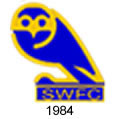 club was back in the First Division. At this stage the crest was modified to include the club's initials. This badge appeared in blue and gold, as shown, or in white.
club was back in the First Division. At this stage the crest was modified to include the club's initials. This badge appeared in blue and gold, as shown, or in white.
Apart from one season in Division Two (1990-91), Wednesday became firmly established at the top for the next twenty years. In the 1992-93 season they visited Wembley four times for a League Cup Final, FA Cup semi-final final and replay.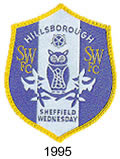 However, they ended the season without adding any silverware to the trophy cabinet.
However, they ended the season without adding any silverware to the trophy cabinet.
In 1995 a new crest was adopted with an altogether more traditional feel to it. The original version had a blue and white background, echoing the team's traditional striped shirts but this was replaced by a plain white background in 1997.
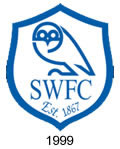 In 1999 the previous crest was replaced by a simplified version that reintroduced the popular, stylised owl as the centrepiece.
In 1999 the previous crest was replaced by a simplified version that reintroduced the popular, stylised owl as the centrepiece.
Wednesday began another downward cycle that took them to the depths of the third tier in 2003. After narrowly avoiding relegation to the basement in 2004, Wednesday returned to the second tier (now the Championship) via the play-offs in 2005. After several campaigns of mixed fortunes, the club was relegated to League One on the last day of the 2009-10 season.
Superstitious supporters favour a blue central stripe on the players' shirts, regarding white central stripes as unlucky.
In a landmark deal in England, Wednesday and Sheffield United shared the same sponsors in 2011-12. Wednesday wore the logo of a Volkswagen dealership on their home shirts and that of Westfield Health Insurance Company on their away shirts while United reversed the arrangement. This followed concern expressed by local businesses that by sponsoring one club and not the other some supporters would be alienated from their brand. Similar concerns had led to Celtic and Rangers sharing sponsorship over a decade earlier.
